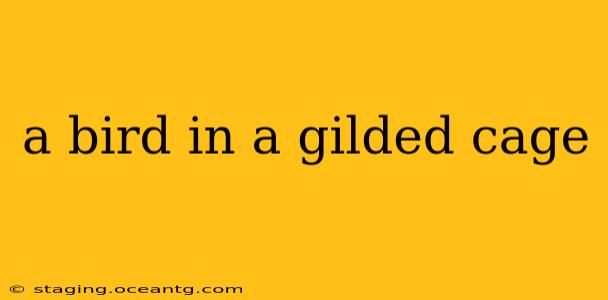The phrase "a bird in a gilded cage" conjures a potent image: opulence masking confinement, luxury concealing a lack of freedom. This evocative metaphor, used for centuries in literature and art, continues to resonate deeply, holding relevance even in today's complex world. This article will delve into the meaning of this phrase, exploring its historical context and examining its contemporary interpretations. We'll also address some frequently asked questions surrounding this enduring symbol.
What does "a bird in a gilded cage" mean?
At its core, "a bird in a gilded cage" describes a situation where someone possesses outward appearances of wealth, comfort, and privilege, yet remains trapped and restricted in their life. The "gilded cage" represents a superficial beauty that hides a fundamental lack of autonomy and genuine happiness. The bird, representing the individual, is surrounded by luxury but ultimately unable to experience true freedom. It’s a powerful image that highlights the contrast between outward appearances and inner reality.
What is the origin of the phrase "a bird in a gilded cage"?
While the precise origin is difficult to pinpoint, the metaphor's usage dates back centuries. Similar imagery appears in various forms throughout literature and art, reflecting the perennial human struggle between material comfort and genuine freedom. The phrase itself gained popularity in the 19th century, often used to describe women constrained by societal expectations and limited opportunities, despite their affluent surroundings.
Is "a bird in a gilded cage" always a negative metaphor?
While predominantly negative, the metaphor can sometimes be used in a more nuanced way. In certain contexts, it can highlight the bittersweet nature of a comfortable yet limiting situation. For instance, someone might acknowledge the advantages of their life while also recognizing the sacrifices made for that comfort. The interpretation ultimately depends on the specific context and the author's intention.
How is the metaphor used in literature?
The "bird in a gilded cage" motif appears extensively in literature, often portraying characters trapped by social conventions, family obligations, or personal limitations. Authors use this powerful image to explore themes of societal constraints, personal sacrifice, and the search for authentic self-expression. Think of characters who inherit wealth but feel suffocated by expectations, or those who sacrifice their dreams for the sake of security and comfort.
What are some modern examples of "a bird in a gilded cage"?
The metaphor remains remarkably relevant in the modern world. We can see it reflected in various situations, from individuals trapped in high-pressure jobs with lucrative salaries but little personal fulfillment to those who inherit family businesses but feel stifled by tradition. Even celebrities, despite their fame and fortune, sometimes express feelings of confinement and a lack of genuine freedom. The concept extends beyond material wealth to encompass any situation where external success masks internal unhappiness and a lack of personal agency.
Can a gilded cage ever be escaped?
The possibility of escape is a central theme when interpreting the metaphor. The answer depends on the individual's resilience, determination, and the specific nature of their "cage." While breaking free may require significant effort and sacrifice, it ultimately represents the pursuit of authenticity and self-determination. Escaping might involve challenging societal norms, pursuing personal passions, or making difficult choices that prioritize personal fulfillment over material comfort.
What is the difference between a gilded cage and a comfortable life?
The key difference lies in the individual's experience and sense of agency. A comfortable life is one where an individual feels content and fulfilled, with a sense of control over their circumstances. A gilded cage, on the other hand, implies a lack of genuine freedom and a feeling of being trapped, regardless of the outward comfort. The difference hinges on whether the individual feels truly empowered to make their own choices or if they feel constrained by external forces, even if those forces provide a materially comfortable existence.
In conclusion, "a bird in a gilded cage" remains a powerful and enduring metaphor that continues to resonate with audiences across generations. Its capacity to capture the complexities of the human condition ensures its continued relevance in literature, art, and everyday life. The metaphor serves as a constant reminder that true happiness and fulfillment often lie not in material wealth but in the pursuit of freedom and authenticity.
